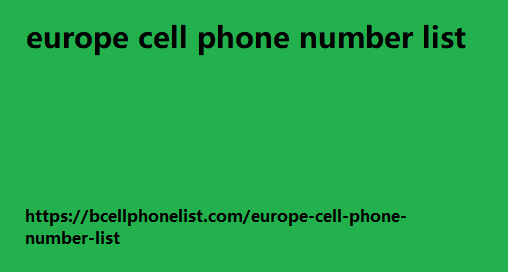Data roaming refers to the ability of mobile device users to access the internet and use data services when they travel outside their home network coverage area. When a user travels abroad, their device connects to a local carrier’s network, allowing them to Introduction to Data Roaming Overseas send messages, browse the internet, and use apps as if they were still at home. While this convenience enhances connectivity for travelers, it also raises important considerations regarding costs, service quality, and data usage limits.
2. How Data Roaming Works
When a mobile user travels overseas, their device utilizes roaming agreements between their home carrier and local foreign carriers. These agreements europe cell phone number list enable users to connect to a local network, allowing for the continuation of service. The device communicates with the local carrier’s infrastructure, which routes calls, texts, and data back to the user’s home carrier. This seamless connectivity is essential for travelers, as it allows them to stay connected without the need to change SIM cards or purchase new devices.
3. Cost Implications of Data Roaming
One of the significant concerns for travelers using data roaming is the potential for high costs. Many carriers charge exorbitant rates for data usage abroad, leading to unexpectedly high bills upon return. These charges can accumulate quickly, especially Doktè a oswa enfimyè tou for users who frequently check emails, use navigation apps, or stream media. To avoid surprises, travelers are encouraged to check their carrier’s roaming rates and consider purchasing international data plans or packages that offer a set amount of data for a fixed fee.
4. Managing Data Usage While Roaming
Travelers must manage their data usage carefully to avoid incurring high costs. Most smartphones provide settings that allow users to monitor data consumption and set limits for specific apps. Additionally, users can disable automatic updates and background data for apps to reduce usage while roaming. Utilizing Wi-Fi networks whenever possible is another effective way to minimize data consumption. Many hotels, cafes, and public spaces offer free Wi-Fi, allowing travelers to connect without relying on their mobile data.
5. Alternatives to Data Roaming
For those concerned about the costs and limitations associated with data roaming, several alternatives are available. Purchasing a local SIM card upon arrival aqb directory in the destination country is a popular option, providing users with local rates and potentially unlimited data. Additionally, portable Wi-Fi devices or “MiFi” can be rented to create a personal hotspot, enabling multiple devices to connect to the internet without incurring roaming fees. These alternatives can provide more predictable costs and enhance the travel experience.
6. Conclusion: The Future of Data Roaming
As global travel continues to grow, the landscape of data roaming is evolving. Many countries are working towards regulations that limit roaming charges, making it more affordable for travelers. The European Union, for example, has implemented regulations to eliminate roaming fees within member states. As technology advances, travelers can expect improved services, better coverage, and more competitive pricing in the data roaming market. Staying informed about options and managing data usage will continue to be essential for users seeking to stay connected while abroad.


